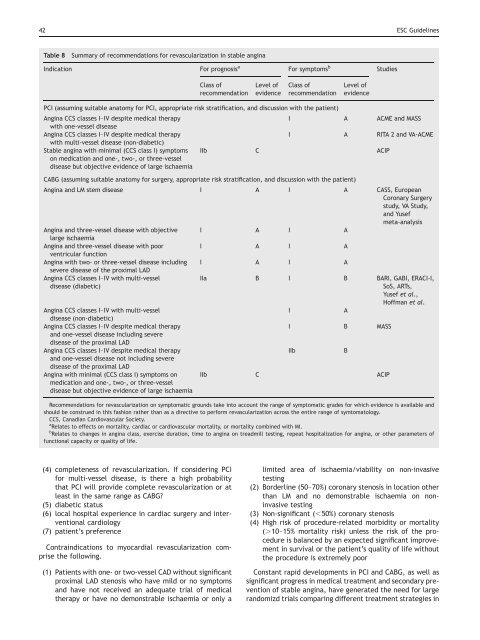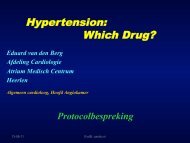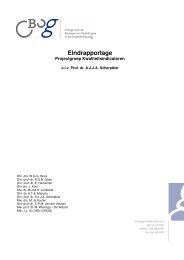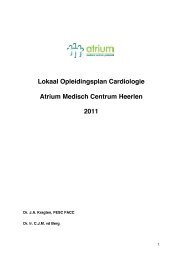42 ESC <str<strong>on</strong>g>Guidelines</str<strong>on</strong>g>Table 8Summary <strong>of</strong> recommendati<strong>on</strong>s for revascularizati<strong>on</strong> in stable anginaIndicati<strong>on</strong> For prognosis a For symptoms b StudiesClass <strong>of</strong>recommendati<strong>on</strong>Level <strong>of</strong>evidenceClass <strong>of</strong>recommendati<strong>on</strong>Level <strong>of</strong>evidencePCI (assuming suitable anatomy for PCI, appropriate risk stratificati<strong>on</strong>, and discussi<strong>on</strong> with <strong>the</strong> patient)<strong>Angina</strong> CCS classes I–IV despite medical <strong>the</strong>rapyI A ACME and MASSwith <strong>on</strong>e-vessel disease<strong>Angina</strong> CCS classes I–IV despite medical <strong>the</strong>rapyI A RITA 2 and VA-ACMEwith multi-vessel disease (n<strong>on</strong>-diabetic)<strong>Stable</strong> angina with minimal (CCS class I) symptoms IIb C ACIP<strong>on</strong> medicati<strong>on</strong> and <strong>on</strong>e-, two-, or three-vesseldisease but objective evidence <strong>of</strong> large ischaemiaCABG (assuming suitable anatomy for surgery, appropriate risk stratificati<strong>on</strong>, and discussi<strong>on</strong> with <strong>the</strong> patient)<strong>Angina</strong> and LM stem disease I A I A CASS, EuropeanCor<strong>on</strong>ary Surgerystudy, VA Study,and Yusefmeta-analysis<strong>Angina</strong> and three-vessel disease with objective I A I Alarge ischaemia<strong>Angina</strong> and three-vessel disease with poorI A I Aventricular functi<strong>on</strong><strong>Angina</strong> with two- or three-vessel disease including I A I Asevere disease <strong>of</strong> <strong>the</strong> proximal LAD<strong>Angina</strong> CCS classes I–IV with multi-vesseldisease (diabetic)IIa B I B BARI, GABI, ERACI-I,SoS, ARTs,Yusef et al.,H<strong>of</strong>fman et al.<strong>Angina</strong> CCS classes I–IV with multi-vesselIAdisease (n<strong>on</strong>-diabetic)<strong>Angina</strong> CCS classes I–IV despite medical <strong>the</strong>rapyI B MASSand <strong>on</strong>e-vessel disease including severedisease <strong>of</strong> <strong>the</strong> proximal LAD<strong>Angina</strong> CCS classes I–IV despite medical <strong>the</strong>rapyIIbBand <strong>on</strong>e-vessel disease not including severedisease <strong>of</strong> <strong>the</strong> proximal LAD<strong>Angina</strong> with minimal (CCS class I) symptoms <strong>on</strong>medicati<strong>on</strong> and <strong>on</strong>e-, two-, or three-vesseldisease but objective evidence <strong>of</strong> large ischaemiaIIb C ACIPRecommendati<strong>on</strong>s for revascularizati<strong>on</strong> <strong>on</strong> symptomatic grounds take into account <strong>the</strong> range <strong>of</strong> symptomatic grades for which evidence is available andshould be c<strong>on</strong>strued in this fashi<strong>on</strong> ra<strong>the</strong>r than as a directive to perform revascularizati<strong>on</strong> across <strong>the</strong> entire range <strong>of</strong> symtomatology.CCS, Canadian <strong>Cardio</strong>vascular Society.a Relates to effects <strong>on</strong> mortality, cardiac or cardiovascular mortality, or mortality combined with MI.b Relates to changes in angina class, exercise durati<strong>on</strong>, time to angina <strong>on</strong> treadmill testing, repeat hospitalizati<strong>on</strong> for angina, or o<strong>the</strong>r parameters <strong>of</strong>functi<strong>on</strong>al capacity or quality <strong>of</strong> life.(4) completeness <strong>of</strong> revascularizati<strong>on</strong>. If c<strong>on</strong>sidering PCIfor multi-vessel disease, is <strong>the</strong>re a high probabilitythat PCI will provide complete revascularizati<strong>on</strong> or atleast in <strong>the</strong> same range as CABG?(5) diabetic status(6) local hospital experience in cardiac surgery and interventi<strong>on</strong>alcardiology(7) patient’s preferenceC<strong>on</strong>traindicati<strong>on</strong>s to myocardial revascularizati<strong>on</strong> comprise<strong>the</strong> following.(1) Patients with <strong>on</strong>e- or two-vessel CAD without significantproximal LAD stenosis who have mild or no symptomsand have not received an adequate trial <strong>of</strong> medical<strong>the</strong>rapy or have no dem<strong>on</strong>strable ischaemia or <strong>on</strong>ly alimited area <strong>of</strong> ischaemia/viability <strong>on</strong> n<strong>on</strong>-invasivetesting(2) Borderline (50–70%) cor<strong>on</strong>ary stenosis in locati<strong>on</strong> o<strong>the</strong>rthan LM and no dem<strong>on</strong>strable ischaemia <strong>on</strong> n<strong>on</strong>invasivetesting(3) N<strong>on</strong>-significant (,50%) cor<strong>on</strong>ary stenosis(4) High risk <strong>of</strong> procedure-related morbidity or mortality(.10–15% mortality risk) unless <strong>the</strong> risk <strong>of</strong> <strong>the</strong> procedureis balanced by an expected significant improvementin survival or <strong>the</strong> patient’s quality <strong>of</strong> life without<strong>the</strong> procedure is extremely poorC<strong>on</strong>stant rapid developments in PCI and CABG, as well assignificant progress in medical treatment and sec<strong>on</strong>dary preventi<strong>on</strong><strong>of</strong> stable angina, have generated <strong>the</strong> need for largerandomizd trials comparing different treatment strategies in
ESC <str<strong>on</strong>g>Guidelines</str<strong>on</strong>g> 43selected groups <strong>of</strong> patients. Many questi<strong>on</strong>s in <strong>the</strong> management<strong>of</strong> stable angina remain incompletely answered, andfur<strong>the</strong>r questi<strong>on</strong>s are generated by <strong>the</strong> development <strong>of</strong>new treatment modalities, necessitating <strong>the</strong> c<strong>on</strong>stant revisi<strong>on</strong>and updating <strong>of</strong> <strong>the</strong>se guidelines and a need for practisingclinicians to remain abreast <strong>of</strong> current literature in <strong>the</strong>area in <strong>the</strong> interim.Recommendati<strong>on</strong>s for revascularizati<strong>on</strong> to improveprognosis in patients with stable anginaClass I(1) CABG for significant LM CAD or its equivalent (i.e.severe stenosis <strong>of</strong> ostial/proximal segment <strong>of</strong> left descendingand circumflex cor<strong>on</strong>ary arteries) (level <strong>of</strong> evidenceA)(2) CABG for significant proximal stenosis <strong>of</strong> three majorvessels, particularly in those patients with abnormalLV functi<strong>on</strong> or with early or extensive reversible ischaemia<strong>on</strong> functi<strong>on</strong>al testing (level <strong>of</strong> evidence A)(3) CABG for <strong>on</strong>e- or two-vessel disease with high-gradestenosis <strong>of</strong> proximal LAD with reversible ischaemia <strong>on</strong>n<strong>on</strong>-invasive testing (level <strong>of</strong> evidence A)(4) CABG for significant disease with impaired LV functi<strong>on</strong>and viability dem<strong>on</strong>strated by n<strong>on</strong>-invasive testing(level <strong>of</strong> evidence B)Class IIa(1) CABG for <strong>on</strong>e- or two-vessel CAD without significantproximal LAD stenosis in patients who have survivedsudden cardiac death or sustained ventricular tachycardia(level <strong>of</strong> evidence B)(2) CABG for significant three-vessel disease in diabeticswith reversible ischaemia <strong>on</strong> functi<strong>on</strong>al testing (level<strong>of</strong> evidence C)(3) PCI or CABG for patients with reversible ischaemia <strong>on</strong>functi<strong>on</strong>al testing and evidence <strong>of</strong> frequent episodes<strong>of</strong> ischaemia during daily activities (level <strong>of</strong> evidence C)Recommendati<strong>on</strong>s for revascularizati<strong>on</strong> to improvesymptoms in patients with stable anginaClass I(1) CABG for multi-vessel disease technically suitable forsurgical revascularizati<strong>on</strong> in patients with moderateto-severesymptoms not c<strong>on</strong>trolled by medical<strong>the</strong>rapy, in whom risks <strong>of</strong> surgery do not outweighpotential benefits (level <strong>of</strong> evidence A)(2) PCI for <strong>on</strong>e-vessel disease technically suitable forpercutaneous revascularizati<strong>on</strong> in patients withmoderate-to-severe symptoms not c<strong>on</strong>trolled bymedical <strong>the</strong>rapy, in whom procedural risks do not outweighpotential benefits (level <strong>of</strong> evidence A)(3) PCI for multi-vessel disease without high-risk cor<strong>on</strong>aryanatomy, technically suitable for percutaneous revascularizati<strong>on</strong>in patients with moderate-to-severe symptomsnot c<strong>on</strong>trolled by medical <strong>the</strong>rapy, in whomprocedural risks do not outweigh potential benefits(level <strong>of</strong> evidence A)Class IIa(1) PCI for <strong>on</strong>e-vessel disease technically suitable forpercutaneous revascularizati<strong>on</strong> in patients with mildto-moderatesymptoms which are n<strong>on</strong>e<strong>the</strong>lessunacceptable to <strong>the</strong> patient, in whom proceduralrisks do not outweigh potential benefits (level <strong>of</strong> evidenceA)(2) CABG for <strong>on</strong>e-vessel disease technically suitable forsurgical revascularizati<strong>on</strong> in patients with moderateto-severesymptoms not c<strong>on</strong>trolled by medical<strong>the</strong>rapy, in whom operative risk does not outweighpotential benefit (level <strong>of</strong> evidence A)(3) CABG for multi-vessel disease technically suitable forsurgical revascularizati<strong>on</strong> in patients with mildto-moderatesymptoms which are n<strong>on</strong>e<strong>the</strong>less unacceptableto <strong>the</strong> patient, in whom operative risk does notoutweigh potential benefit (level <strong>of</strong> evidence A)(4) PCI for multi-vessel disease technically suitable forpercutaneous revascularizati<strong>on</strong> in patients withmild-to-moderate symptoms which are n<strong>on</strong>e<strong>the</strong>lessunacceptable to <strong>the</strong> patient, in whom procedural risksdo not outweigh potential benefits (level <strong>of</strong> evidence A)Class IIb(1) CABG for <strong>on</strong>e-vessel disease technically suitable forsurgical revascularizati<strong>on</strong> in patients with mild-tomoderatesymptoms which are n<strong>on</strong>e<strong>the</strong>less unacceptableto <strong>the</strong> patient, in whom operative risk is notgreater than <strong>the</strong> estimated annual mortality (level <strong>of</strong>evidence B)Treatment <strong>of</strong> stable angina: multi-targeted treatment <strong>of</strong> amulti-faceted diseaseIn his/her lifetime, <strong>the</strong> patient with stable angina may meetepisodes <strong>of</strong> exercise/stress-induced symptomatic myocardialischaemia (angina pectoris), silent ischaemia, progressiveangina, acute cor<strong>on</strong>ary syndromes (unstable angina and MI),acute and chr<strong>on</strong>ic heart failure, and life-threatening arrhythmias.Prol<strong>on</strong>ged periods <strong>of</strong> stability may alternate withperiods <strong>of</strong> instability (sudden progressi<strong>on</strong> and acute cor<strong>on</strong>arysyndromes). According to <strong>the</strong> state <strong>of</strong> <strong>the</strong> disease, a patientwill require treatment aimed at retardati<strong>on</strong> <strong>of</strong> <strong>the</strong> progressi<strong>on</strong><strong>of</strong> disease (preventi<strong>on</strong>), management <strong>of</strong> symptomatic disease(angina pectoris), management <strong>of</strong> acute cor<strong>on</strong>ary syndromes,and management <strong>of</strong> heart failure or life-threatening arrhythmias.The physician should be prepared to <strong>of</strong>fer <strong>the</strong> appropriate<strong>the</strong>rapy at <strong>the</strong> appropriate time. The different modes <strong>of</strong>preventive <strong>the</strong>rapy, symptomatic medical <strong>the</strong>rapy, such aspercutaneous and surgical cor<strong>on</strong>ary revascularizati<strong>on</strong> andmanagement <strong>of</strong> arrhythmias, are all rapidly evolving and soit is recommended that an individual physician operateswithin a team which can <strong>of</strong>fer <strong>the</strong> appropriate <strong>the</strong>rapy at<strong>the</strong> appropriate time with <strong>the</strong> appropriate skills.Special subgroupsWomenThe evaluati<strong>on</strong> <strong>of</strong> chest pain in women is less straightforwardthan in men at multiple levels, because <strong>of</strong> genderdifferences in presentati<strong>on</strong> and disease manifestati<strong>on</strong> 619and also <strong>the</strong> prep<strong>on</strong>derance <strong>of</strong> male-specific data in <strong>the</strong>published literature.There are numerous differences in <strong>the</strong> epidemiology andprimary manifestati<strong>on</strong> <strong>of</strong> CHD in women and men. <strong>Stable</strong>angina is <strong>the</strong> most frequent initial manifestati<strong>on</strong> <strong>of</strong> CHD inwomen, but MI or sudden death <strong>the</strong> most frequent initialmanifestati<strong>on</strong> in men. 40,41,620 Although <strong>the</strong> incidence <strong>of</strong>














